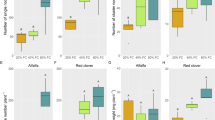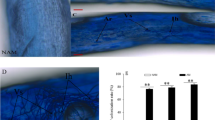Abstract
Key message
Seedlings of three Fagaceae species planted on acidic, infertile colluvial soil showed accelerated growth when inoculated with ectomycorrhizal fungi.
Abstract
We conducted a study with seedlings of Fagaceae species inoculated with ectomycorrhizal fungi to estimate their utility for growth in acidic soil conditions. We selected Quercus glauca, Quercus salicina and Castanopsis cuspidata as typical evergreen, broad-leaved, woody species of southwestern Japan. Seedlings were inoculated with Astraeus hygrometricus or Scleroderma citrinum, and planted in acidic, infertile colluvial soil collected from an abandoned site. Six months after planting, seedlings of the three species inoculated with A. hygrometricus were growing well, especially, Q. salicina. The growth of seedlings inoculated with S. citrinum was inferior to seedlings inoculated with A. hygrometricus. In contrast, seedlings without ectomycorrhizal fungi did not grow well. Differences in growth among the three types of seedlings were related to differences in the levels of nutrient acquisition. We concluded that Fagaceae seedlings inoculated with A. hygrometricus were best suited for acidic, infertile environments.



Similar content being viewed by others
References
Aggangan NS, Aggangan JS, Bulan JCO, Limos CAS (2012) Inoculation of dipterocarps Anisoptera thurifera and Shorea guiso with ectomycorrhizal fungi in Philippine red soil. Philos J Sci 141:229–241
Akama K, Okabe H, Yamanaka T (2008) Growth of ectomycorrhizal fungi on various culture media. Bull FFPRI 7:165–181 (in Japanese and English summary)
American Public Health Association, American Water Works Association, Water Environment Federation (1998) Standard methods for the examination of water and wastewater. American Public Health Association, Washington, DC
Calvaruso C, Turpault M-P, Leclerc E, Ranger J, Garbaye J, Uroz S, Frey-Klett P (2010) Influence of forest trees on the distribution of mineral weathering-associated bacterial communities of the Scleroderma citrinum mycorrhizosphere. Appl Environ Microbiol 76:4780–4787
Chalot M, Brun A (1998) Physiology of organic nitrogen acquisition by ectomycorrhizal fungi and ectomycorrhiza. FEMS Microbiol Rev 22:21–44
Fang JY, Song YC, Liu HY, Piao SL (2002) Vegetation–climate relationship and its application in the division of vegetation zone in China. Acta Bot Sin 44:1105–1122
Fangfuk W, Okada K, Petchang R, To-anun C, Fukuda M, Yamada A (2010) In vitro mycorrhization of edible Astraeus mushrooms and their morphological characterization. Mycoscience 51:234–241
Gebhardt S, Neubert K, Wöllecke J, Münzenberger B, Hüttl RF (2007) Ectomycorrhiza communities of red oak (Quercus rubra L.) of different age in the Lusatian lignite mining district, east Germany. Mycorrhiza 17:279–290
Hentschel E, Godbold DL, Marschner P, Schlegel H, Jentschke G (1993) The effect of Paxillus involutus Fr. On aluminium sensitivity of Norway spruce seedlings. Tree Physiol 12:379–390
Horikawa Y (1972) Atlas of the Japanese flora, an introduction to plant sociology of East Asia. Gakken, Tokyo
Ishimaru K, Tokuchi N, Osawa N, Kawamura K, Takeda H (2005) Behavior of four broad-leaved tree species used to revegetate eroded granite hill slopes. J Forest Res 10:27–34
Ito S, Ohtsuka K, Yamashita T (2007) Ecological distribution of seven evergreen Quercus species. Veg Sci 24:53–63
Japan Meteorological Agency (2009) Climate statistics. http://www.data.jma.go.jp/obd/stats/etrn/index.php
Jentschke G, Godbold DL (2000) Metal toxicity and ectomycorrhizas. Physiol Plant 109:107–116
Jung NC, Tamai Y (2012) Anatomical observation of polyphenol changes in epidermal cells during the development of Quercus acutissima–Scleroderma verrucosum ectomycorrhizae
Kayama M, Maeda Y, Tanaka H (2009) Physiological characteristics of the saplings planted on the site of large scale clear-cutting. Kyushu J Forest Res 64:94–97 (in Japanese)
Kimoto A, Mizuyama T, Okano K (2002) Spatial and temporal changes of vegetation cover in granite mountains in central Japan: a GIS-based approach. Land Degrad Dev 13:345–357
Kira T (1991) Forest ecosystems of east and southeast Asia in a global perspective. Ecol Res 6:185–200
Kochian LV, Hoekenga OA, Piñeros MA (2004) How do crop plants tolerance acid soils? Mechanisms of aluminum tolerance and phosphorus efficiency. Annu Rev Plant Biol 55:459–493
Kumlung A, Takeda Y (1991) Changes of soil properties in relation to lapsed years of hillside works on a granite area. J Jap For Soc 73:327–338
Lambers H, Chapin FS III, Pons TL (1998) Plant physiological ecology. Springer, New York
Lehto T, Zwiazek JJ (2011) Ectomycorrhizas and water relations of trees: a review. Mycorrhiza 21:71–90
Maesako S, Yonemaru S, Sakai M (2002) Comparative studies of the physical and chemical properties of surface soils in a sugi plantation and it’s two adjacent broad-leaved forest stands. Bull Kagoshima Pref For Exp Stn 7:14–22 (in Japanese)
Maestre FT, Bautista S, Cortina J, Díaz G, Honrubia M, Vallejo R (2002) Microsite and mycorrhizal inoculum effects on the establishment of Quercus coccifera in a semi-arid degraded steppe. Ecol Eng 19:289–295
Makita N, Hirano Y, Yamanaka T, Yoshimura K, Kosugi Y (2012) Ectomycorrhizal-fungal colonization induces physio-morphological changes in Quercus serrata leaves and roots. J Plant Nutr Soil Sci 17:900–906
Marx DH, Maul SB, Cordell CE (1992) Application of specific ectomycorrhizal fungi in world forestry. In: Leatham GF (ed) Frontiers in industrial mycology. Chapman and Hall, New York, pp 78–98
Matsuda Y, Takano Y, Shimada H, Yamanaka T, Ito S (2013) Distribution of ectomycorrhizal fungi in a Chamaecyparis obtusa stand at different distances from a mature Quercus serrate tree. Mycoscience 54:260–264
Matsumoto K, Kosugi Y, Katsuyama M, Tani M, Ohkubo S, Takanashi S (2011) Estimation of bedrock infiltration on a weathered granitic mountain covered by Japanese cypress forest using water-budget and eddy covariance methods. Int J Erosion Cont Eng 4:10–20
Menitsky YL (2005) Oaks of Asia. Science Publishers, Enfield
Miyabuchi Y, Tanaka H (2009) Slope failures in and around a large-scale abandoned forest after clear-cutting, southern Kyushu, Japan. Jap Soc Erosion Cont Eng 62:51–55 (in Japanese and English summary)
Mohan V, Natarajan K, Ingleby K (1993) Anatomical studies of ectomycorrhizas. III. The ectomycorrhizas produced by Rhizopogon luteolus and Scleroderma citrinum on Pinus patula. Mycorrhiza 3:51–56
Noda I, Hayashi M (2004) Characteristic differences of non-reforested land compared with reforested land in Kumamoto, Kyushu. Bull FFPRI 3:29–32
Noodén LD (2004) Plant cell death processes. Elsevier Academic Press, San Diego
Núñez JAD, Serrano JS, Barreal JAR, González JASO (2006) The influence of mycorrhization with Tuber melanosprum in the afforestation of a Mediterranean site with Quercus ilex and Quercus faginea. For Ecol Manage 231:226–233
Oh KI, Melville LH, Peterson RL (1995) Comparative structural study of Quercus serrata and Q. acutissima formed by Pisolithus tinctorius and Hebeloma cylindrosporum. Trees 9:171–179
Ohta A (1990) A new medium for mycelial growth of mycorrhizal fungi. Trans Mycol Soc Japan 31:323–334
Phosri C, Martín MP, Sihanonth P, Whalley AJS, Watling R (2007) Molecular study of the genus Astraeus. Mocol Res 111:275–286
Plassard C, Dell B (2010) Phosphorus nutrition of mycorrhizal trees. Tree Physiol 30:1129–1139
Quoreshi AM, Timmer VR (1998) Exponential fertilization increases nutrient uptake and ectomycorrhizal development of black spruce seedlings. Can J Forest Res 28:674–682
Saigusa M, Shoji S, Takahashi T (1980) Plant root growth in acid andosols from northeastern Japan: 2. Exchange acidity Y1 as a realistic measure of aluminium toxicity potential. Soil Sci 130:242–250
Sheng JA, Liao AZ (1997) Erosion control in south China. Catena 29:211–221
Sparks DL, Page AL, Helmke PA, Loeppert RH, Soltanpour PN, Tabatabai MA, Johnson CT, Sumner ME (1996) Methods of soil analysis, Part 3. Soil Science Society of America Inc., Madison
Stokes A, Atger C, Bengouth AG, Fourcaud T, Sidle RC (2009) Desirable plant root traits for protecting natural and engineered slopes against landslides. Plant Soil 324:1–30
Tam PCF, Griffiths DA (1993) Mycorrhizal associations in Hong Kong Fagaceae. III. The ontogeny of mycorrhizal development, growth and nutrient uptake by Quercus myrsinaefolia seedlings inoculated with Pisolithus tinctorius. Mycorrhiza 2:125–131
Trac CJ, Harrell S, Hinckley TM, Henck AC (2007) Reforestation programs in southwest China: reported success, observed failure, and the reasons why. J Mt Sci 4:275–292
van Reeuwijk LP (1993) Procedures for soil analysis. International soil reference and information centre, Wagningen
van Schöll L, Kuyper TW, Smits MM, Landeweert R, Hoffland E, van Breemen N (2008) Rock-eating mycorrhizas: their role in plant nutrition and biogeochemical cycles. Plant Soil 303:35–47
Villar-Salvador P, Heredia N, Millard P (2010) Remobilization of acorn nitrogen for seedling growth in holm oak (Quercus ilex), cultivated with contrasting nutrient availability. Tree Physiol 30:257–263
Walker RF (1990) Ectomycorrhizal formation by Pisolithus tinctorius on Quercus gambelii × Quercus turbinella hybrid in an acidic Sierra Nevada minesoil. Great Basin Nat 50:367–370
Wang B, Qiu Y-L (2006) Phylogenic distribution and evolution of mycorrhizas in land plants. Mycorrhiza 16:299–363
Wang J, Ren H, Yang L, Li D (2011) Factors influencing establishment by direct seedling of indigenous tree species in typical plantations and shrubland in south China. New For 42:19–33
Wilson AW, Binder M, Hibbett DS (2012) Diversity and evolution of ectomycorrhizal host associations in the Sclerodermatineae (Boletales, Basidiomycota). New Phytol 194:1079–1095
Xu XN (2001) Differences of soil properties between evergreen broad-leaved and pine forests in northern Okinawa Island, Japan. Jpn J For Environ 43:1–8
Yoshimi S (2002) Taxonomic study of the Japanese taxa of Scleroderma Pers. Jap J Mycol 43:3–18 (in Japanese and English summary)
Acknowledgments
We thank researchers at Kyushu Research Center, FFPRI for their encouragement. For the collection of ECM fungi, we also thank Dr. Y. Matsuda for his corporation. We thank Ms. N Aoki for assistance with the phytotron experiment. Moreover, we thank Ms. Y. Narimatsu and T. Kokuryo for analysis of Fagaceae seedlings. For analysis of the concentration of Al using an ICP analyzer, we are grateful to Dr. H. Kubotera, National Agriculture and Food Research Organization. Thanks are due to Dr. K. Fukuzawa, Northern Forestry Research and Development Office, FSC, Hokkaido University for soil analysis. This research was supported by funding from the Ministry of Agriculture, Forestry and Fishery (Research and Development Projects for Application in Promoting New Policy of Agriculture, Forestry and Fishery, No. 1904: Development of Regeneration Technology for Leading Artificial Coniferous Forest to Broad-Leaf Forests).
Conflict of interest
The source support for this study is a non-profit organization (Ministry of Agriculture, Forestry and Fishery). We declare that our research has no conflict of interest.
Author information
Authors and Affiliations
Corresponding author
Additional information
Communicated by P. Courty.
Rights and permissions
About this article
Cite this article
Kayama, M., Yamanaka, T. Growth characteristics of ectomycorrhizal seedlings of Quercus glauca, Quercus salicina, and Castanopsis cuspidata planted on acidic soil. Trees 28, 569–583 (2014). https://doi.org/10.1007/s00468-013-0973-y
Received:
Revised:
Accepted:
Published:
Issue Date:
DOI: https://doi.org/10.1007/s00468-013-0973-y




